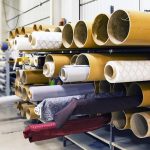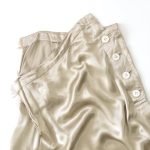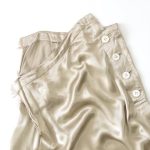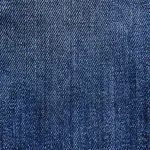Are you tired of dealing with fraying leather ends on your fabric? Look no further! This article will guide you through the steps to prevent fraying and keep your fabric looking flawless.
By understanding the fraying problem, choosing the right leather, and using adhesive, stitching techniques, and heat sealing methods, you can achieve long-lasting results.
Additionally, we’ll provide tips for adding reinforcements and maintaining your leather ends to prevent fraying over time.
Say goodbye to frayed ends and hello to a polished finish!
Table of Contents
Understanding the Fraying Problem
You might be wondering why leather ends have a tendency to fray when used on fabric. Well, the fraying problem arises due to various factors, including the thickness of the leather and the nature of the fabric. When choosing leather for use on fabric, it is important to consider its thickness. Thicker leather tends to be more durable and less prone to fraying. Therefore, opt for a leather thickness that is suitable for the specific project at hand.
Another way to prevent fraying is to consider alternative materials. Instead of using leather ends, you can use alternative materials that are specifically designed to prevent fraying. For example, there are fabric sealants available in the market that can be applied to the fabric edges to prevent fraying. These sealants create a protective barrier that keeps the fabric intact and prevents fraying.
Furthermore, you can also consider using binding tapes or bias tapes to finish the edges of the fabric. These tapes are made of materials such as cotton or polyester, which are less likely to fray. They can be easily sewn onto the fabric edges, providing a clean and durable finish.
Choosing the Right Leather for Fabric
To ensure your leather doesn’t unravel when paired with fabric, it’s important to select the appropriate type of leather. Choosing durable leather is crucial for preventing fraying and maintaining the integrity of your leather-fabric combination.
Here are three key factors to consider when selecting leather for fabric:
-
Full-grain leather: This type of leather is the strongest and most durable option available. It has not been sanded or buffed, preserving the natural grain and strength of the hide. Full-grain leather is resistant to fraying and will hold up well when used alongside fabric.
-
Top-grain leather: Although slightly less durable than full-grain leather, top-grain leather is still a good choice for fabric pairing. It is sanded to remove blemishes and imperfections, but the underlying strength of the hide remains intact. This type of leather offers a balance between durability and a smoother finish.
-
Bonded leather: While not as durable as full-grain or top-grain leather, bonded leather can still be a suitable option for fabric combinations. It is made by bonding leather scraps together with a polyurethane coating. While it may not have the same longevity as other types of leather, it can still withstand fraying when used with fabric.
Preparing the Leather Ends
When it comes to cutting leather, it’s important to use the right techniques to ensure clean and precise cuts. By using a sharp utility knife or leather shears, you can achieve smooth edges without fraying.
Additionally, applying sealants such as leather edge paint or edge kote can help prevent fraying and add a professional finish to your leather projects.
Cutting Techniques for Leather
Cutting leather with sharp scissors or a rotary cutter can help prevent fraying on the fabric edges. When cutting leather, it’s important to use the right techniques to ensure clean and precise cuts. Here are three cutting techniques to consider:
- Use a straight edge ruler or template to guide your cuts and maintain straight lines.
- Apply steady pressure while cutting to avoid jagged edges and uneven cuts.
- Cut in one smooth motion rather than sawing back and forth to minimize fraying.
In addition to cutting techniques, adhesive application can also help prevent fraying on fabric edges. Applying fabric glue or leather adhesive along the cut edges can provide added reinforcement and prevent fraying. Remember to follow the adhesive manufacturer’s instructions for proper application and drying time.
With these cutting techniques and adhesive application, you can keep your leather ends from fraying on fabric and achieve professional-looking results.
Preventing Fraying With Sealants
Using sealants, such as fabric glue or leather adhesive, can help prevent fraying on the edges of your material. Sealant application is an effective fraying prevention technique that ensures the longevity and durability of your leather fabric.
When applying the sealant, make sure to carefully follow the instructions provided by the manufacturer. Start by cleaning the edges of the leather to remove any dirt or residue. Then, apply a thin layer of the sealant on the edges, making sure to cover the entire area. Allow the sealant to dry completely before handling the fabric.
This will create a protective barrier that prevents fraying and keeps the edges neat and tidy. Regularly inspect and reapply the sealant as needed to maintain the integrity of your leather fabric.
Using Adhesive to Prevent Fraying
When it comes to preventing fraying on your leather ends, using adhesive can be an effective solution.
In this discussion, we will explore adhesive application techniques, the best adhesive products to use, and how to achieve long-term fraying prevention.
Adhesive Application Techniques
Applying adhesive is an effective way to prevent fraying on leather ends when working with fabric. To ensure a successful adhesive application, follow these tips:
- Clean the leather ends thoroughly before applying the adhesive. This will remove any dirt or oils that could hinder the adhesion.
- Apply the adhesive evenly and in a thin layer. Too much adhesive can create a messy and uneven finish.
- Allow the adhesive to dry completely before handling or sewing the fabric. This will ensure a strong bond and prevent any fraying from occurring.
While adhesive is a popular method for preventing fraying, there are alternative methods you can try:
- Use a fray check liquid or spray, which creates a barrier that prevents fraying.
- Apply a line of stitching close to the leather ends to secure the fabric and prevent fraying.
- Seal the fabric edges with a clear nail polish or fabric glue to stop fraying.
Best Adhesive Products
There are several adhesive products available that can effectively prevent fraying on different materials. When it comes to preventing fraying on leather ends, the best adhesive techniques involve using specific products designed for this purpose.
One of the top choices is fabric glue, which is easy to apply and dries clear, leaving no visible residue. Another option is adhesive tape, which provides a strong bond and is suitable for various fabrics.
If you prefer a more permanent solution, you can use leather glue, which is specifically formulated to adhere leather to fabric. However, if you are looking for alternative fraying prevention methods, you can also consider using heat-seal tapes or sewing the edges with a zigzag stitch.
These techniques can help you keep your leather ends from fraying and maintain a neat and professional finish.
Long-Term Fraying Prevention
To ensure long-term prevention of fraying, you can try using heat-seal tapes or sewing the edges with a zigzag stitch. These techniques will help maintain the integrity of your fabric and leather ends, ensuring they don’t unravel over time.
Here are three fraying prevention techniques that you can incorporate into your long-term maintenance routine:
- Applying a thin layer of fabric glue along the edges of the fabric and leather to create a strong bond and prevent fraying.
- Using a fabric fray preventer, such as a clear nail polish or fray check, to seal the edges and prevent them from unraveling.
- Adding a layer of clear adhesive tape over the edges of the fabric and leather to provide extra reinforcement and protection against fraying.
Stitching Techniques for Leather Ends
You can prevent leather ends from fraying on fabric by using proper stitching techniques. When sewing leather onto fabric, it’s important to choose the right needle and thread for the job. A heavy-duty needle and strong, durable thread, such as nylon or polyester, will ensure that the stitching holds up over time. Additionally, using a backstitch instead of a straight stitch will provide extra reinforcement and prevent the leather ends from unraveling.
Another technique to prevent fraying is to use sealants or adhesives. These products can be applied to the cut edges of the leather to create a barrier and keep them from fraying. There are several sealants and adhesives available on the market specifically designed for leather, such as leather edge paint or edge kote. These products not only prevent fraying but also give the leather ends a neat and finished look.
To help you better understand the stitching techniques and sealants available for preventing leather ends from fraying, here is a table summarizing some popular options:
| Stitching Technique | Pros | Cons |
|---|---|---|
| Backstitch | Strong and durable | Time-consuming |
| Whipstitch | Quick and easy | Less secure |
| Topstitch | Decorative and visible | May require special foot |
| Leather Edge Paint | Provides a clean finish | Requires careful application |
| Edge Kote | Easy to apply | May crack or peel over time |
Heat Sealing Methods for Long-Lasting Results
For long-lasting results, consider using heat sealing methods on the edges of your leather pieces. Heat sealing techniques provide a reliable way to prevent fraying and ensure that your leather ends stay intact. Here are some alternative fraying prevention methods that you can try:
-
Heat Gun: Use a heat gun to apply heat to the edges of your leather. This will melt the fibers together, creating a sealed edge that is resistant to fraying. Be sure to use caution and keep the heat gun moving to avoid overheating or scorching the leather.
-
Hot Knife: A hot knife is another effective tool for heat sealing leather edges. The heated blade quickly melts the fibers, creating a smooth and sealed edge. This method is especially useful for thicker or tougher leathers.
-
Edge Paint or Glue: Applying edge paint or glue to the edges of your leather can also help prevent fraying. These products create a protective barrier that seals the fibers and adds durability to your leather pieces.
Adding Reinforcements to Leather Ends
Consider reinforcing the edges of your leather pieces to enhance their durability and prevent any potential damage. Reinforcing techniques can help keep your leather ends from fraying and ensure that your fabric remains in top shape. There are various methods you can use to reinforce leather, each with its own advantages and considerations. Here are three alternative solutions you can try:
| Reinforcing Technique | Description | Pros |
|---|---|---|
| Gluing | Apply a leather adhesive along the edges to create a strong bond. | – Easy to apply |
- Provides a clean finish
- Can be used on various leather types |
| Stitching | Sew a line of stitches along the edges to secure the leather in place. | – Offers a sturdy reinforcement - Adds a decorative element
- Can be done by hand or using a sewing machine |
| Binding | Wrap a strip of fabric or bias tape around the edges to protect and strengthen the leather. | – Provides a finished look - Offers additional customization options
- Suitable for thicker leather pieces |
Maintenance Tips for Preventing Fraying Over Time
To maintain the longevity of your leather pieces, it’s important to implement proper maintenance techniques to prevent fraying over time. Fraying not only affects the appearance of your leather items but can also weaken their structure. Here are some tips to help you prevent fraying:
-
Fraying prevention through stitching techniques: Make sure to use strong and durable stitching techniques when working with leather. Double stitching or using a zigzag stitch can provide extra reinforcement to prevent fraying along the edges.
-
The role of heat sealing in preventing fraying: Heat sealing is a technique where the edges of leather are fused together using heat. This creates a tight seal that prevents fraying. You can use a heat gun or a special heat sealing tool to apply heat to the edges of your leather pieces.
-
Regular cleaning and conditioning: Keeping your leather clean and conditioned is essential for preventing fraying. Use a leather cleaner to remove dirt and grime, and apply a leather conditioner to moisturize and protect the leather. This will help to keep the leather supple and less prone to fraying.
Conclusion
In conclusion, by understanding the fraying problem and choosing the right leather for fabric, you can effectively prevent leather ends from fraying.
Preparing the leather ends properly and using adhesive or stitching techniques can provide added protection. Heat sealing methods and adding reinforcements also contribute to long-lasting results.
Additionally, regular maintenance is crucial for preventing fraying over time. By following these tips, you can keep your leather ends in excellent condition and maintain the overall quality of your fabric.
- How Does Ring Spun Cotton Affect Garment Fit and Shape Retention? - August 13, 2024
- What Are the Challenges in Producing Ring Spun Cotton? - August 13, 2024
- Is Ring Spun Cotton Suitable for Plus-Size Clothing? - August 13, 2024






